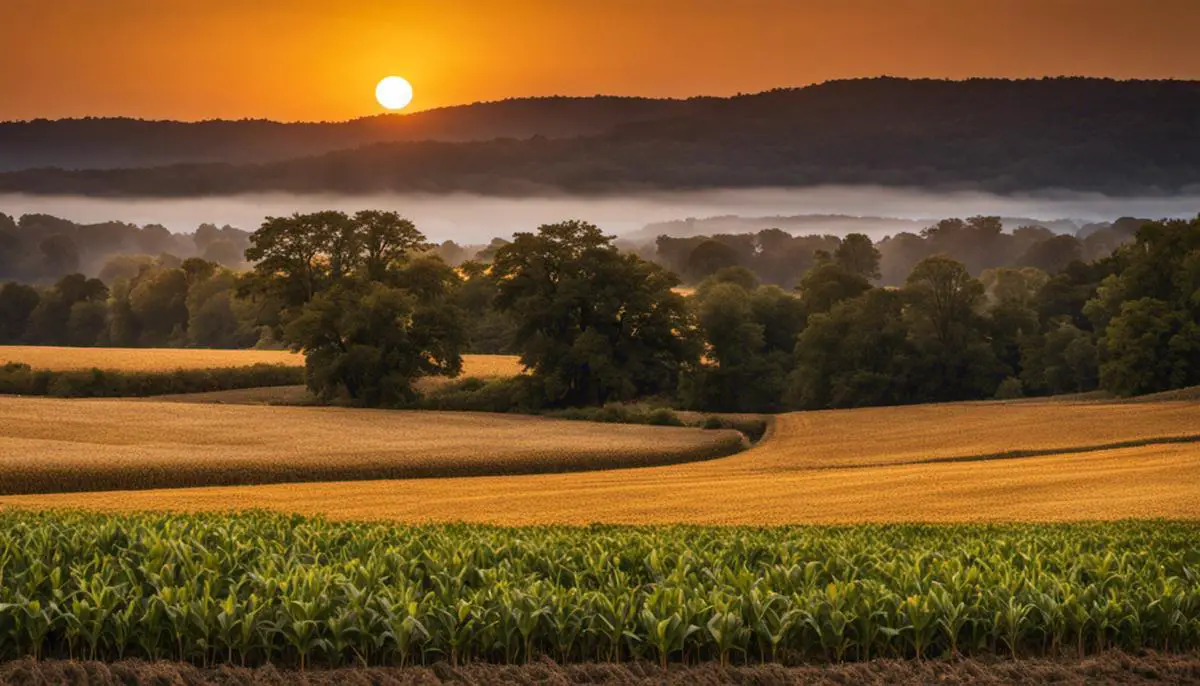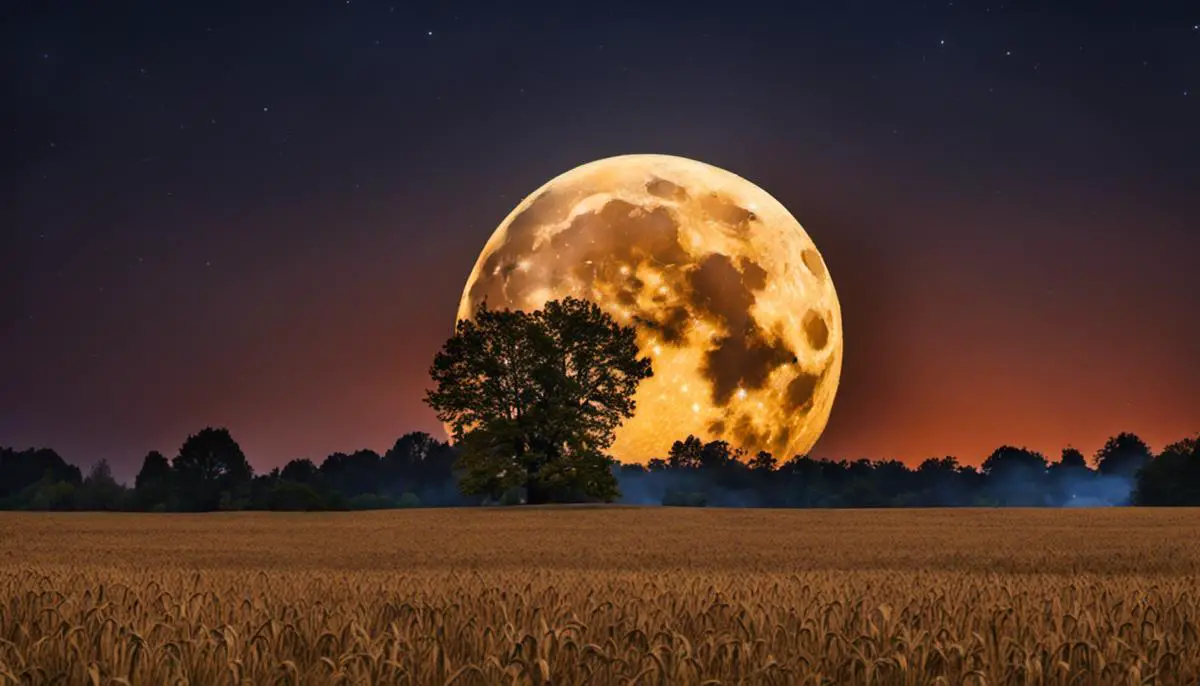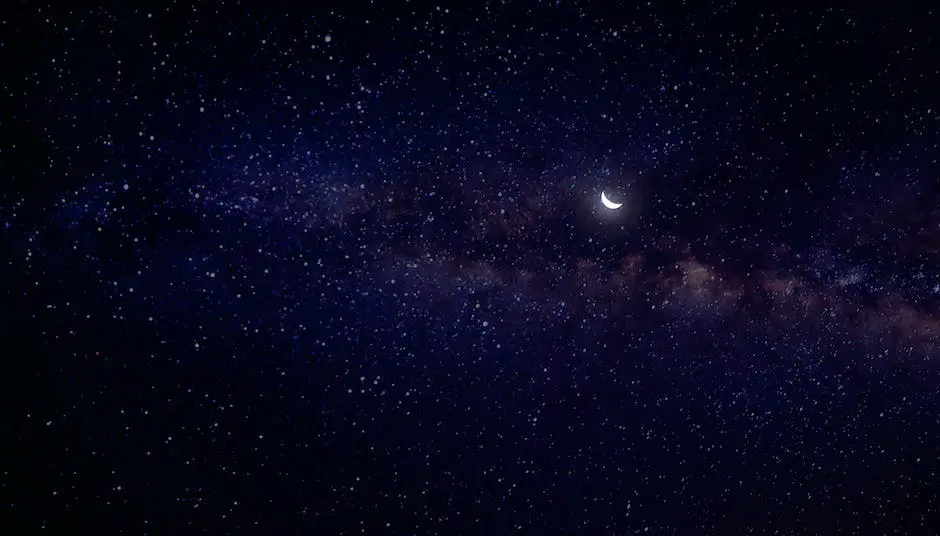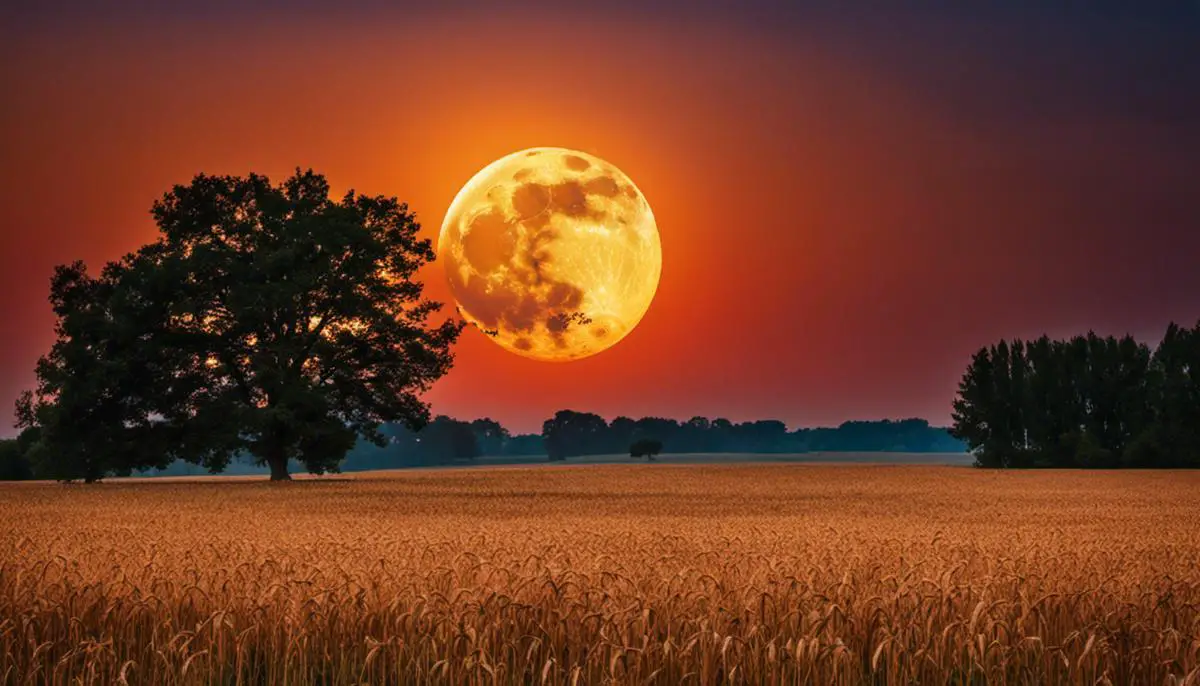The alluring spectacle of the Harvest Moon has enchanted observers for centuries, casting its radiant luminescence across the landscapes. As one of nature’s most captivating shows, the Harvest Moon’s phenomenon, deeply rooted in both our scientific understanding and cultural consciousness, carries an aura of mysticism and wonder, straddling the threshold between the realms of celestial mechanics and folklore. This discourse will unravel the intriguing intricacies involved in the science and relations encompassing the Harvest Moon alongside unfolding an in-depth anticipation of the Harvest Moon 2023. Additionally, it will explore the influential impact of this celestial occurrence on astronomy and agricultural practices, hinging on the powerful duality of its practical implications and symbolic significance.
Understanding the Phenomenon of Harvest Moon
Understanding the Harvest Moon
The Harvest Moon is the full moon that occurs closest to the autumnal equinox, generally marking the beginning of fall. In 2023, the Harvest Moon will fall on September 5th. The Harvest Moon is unique due to its placement in our sky, lying low on the horizon, thus appearing bigger and brighter due to an optical illusion. The cause of this phenomenon is the moon’s elliptical orbit around the earth.
The moon’s orbit is not a perfect circle, but an ellipse, with one side (the perigee) closer to earth, and the other side (the apogee) farther from earth. When the full moon occurs at its perigee, it can appear up to 14% larger and 30% brighter than a typical full moon. This occurrence is often referred to as a ‘Supermoon.’
Along with its optical splendor, the Harvest Moon is historically known for the practical aid it provides for farmers. Prior to the advent of electricity, farmers relied on moonlight to extend their working day during the busy harvest season, hence the term ‘Harvest Moon.’
Cultural Significance of the Harvest Moon
Throughout history and across several cultures, the Harvest Moon has held significant cultural and symbolic importance. For example, in Chinese culture, the Harvest Moon corresponds with the Mid-Autumn Festival, also known as the Moon Festival, where individuals come together to celebrate the summer harvest and observe the bright, bold moon.
In Native American tradition, the Harvest Moon holds different meanings across tribes. The Algonquin people refer to the September full moon as the Corn Moon, indicating an optimal time to harvest corn. The Cree people call it “the leaves falling moon”, signifying the advent of autumn.
The Harvest Moon’s celebrated symbolism extends into popular culture today with numerous songs, films, and books drawing inspiration from this celestial event.
Understanding the Harvest Moon through Scientific Studies
Our very own natural satellite, the moon, continually piques the interest of scientists, encouraging extensive studies of lunar phenomena, such as the Harvest Moon. Our advanced technology facilitates the precise measurement of the distance from the earth to the moon at any given time. This ability further empowers our astronomers to predict future occurrences of perigees and apogees with impressive precision. Beyond moon predictions, these examinations also shed light on the gravitational interactions between the earth and the moon, which dictate our planet’s tidal movements and can instigate minor alterations in its orbital path and rotation speed.

Specifics of Harvest Moon 2023
The Unveiling of Harvest Moon 2023
If you’re interested in lunar phenomena, make a note for the 5th of September, 2023: this is when the Harvest Moon is anticipated to appear. Defined as the first full moon that happens nearest to the autumnal equinox each year, the Harvest Moon stands alone as the sole full moon to occur at the pinnacle of the fall season. An enchanting event, it encapsulates the essence of autumn and is a spectacle not to be missed.
For best viewing, the Harvest Moon 2023 will be visible after sunset in all areas where the sky is clear and unobstructed on 5th September. As it rises, this full moon will appear larger than usual due to its closer proximity to the horizon. Stargazers note the orange or gold color of the moon as it is seen near the horizon, leading to its harvest moniker.
What sets the Harvest Moon apart from other full moon events is its unique behavior. Most full moons rise at a later time each successive night by about 50 minutes, but around the autumnal equinox, a full moon (in this case, the Harvest Moon) rises only around 27 to 30 minutes later daily in U.S and 10 to 20 minutes later for much of Canada and Europe. This establishes a series of early evening moonrises, which historically provided farmers with extra moonlight to harvest crops – hence the name.
In 2023, this phenomenon will be coupled with the fact that Venus, Saturn, and Jupiter will be visible in the same sky as the Harvest Moon, forming quite a definitive celestial spectacle. Venus will appear close to the western horizon, while Jupiter and Saturn will be located further towards the south.
For those interested in capturing this astronomical event, you’ll achieve the best results by using a DSLR or mirrorless camera along with a telephoto lens. Be sure to position yourself in a place with minimal light pollution, and ensure the moon is still close to the horizon for maximum effect on pictures. Remember, this is when the moon appears the largest and has that infamous golden hue; an opportunity you surely don’t want to miss.
September 2023 boasts a fantastic array of astronomical occurrences, providing opportunities for star gazers and moon watchers alike. Most notably, the Harvest Moon, one of the year’s most anticipated events, will occur on September 6th. Two weeks later, on September 19th, is the next new moon. An absence of moonlight on this night will create perfect conditions for viewing the Milky Way and other celestial bodies.

The Impact of Harvest Moon on Astronomy and Agriculture
The Harvest Moon: An Autumnal Spectacle
Mark your calendars for the Harvest Moon on September 6, 2023. Because of its specific position in its elliptical orbit, the moon appears much brighter and seems to rise just after sunset. Unique to the full moon closest to the autumnal equinox, the Harvest Moon often bathes the night sky in a light that is particularly vivid and lasting.
This additional moonlight is a double-edged sword – it enhances the details of the moon’s craters, mountains, and valleys, lighting them up for a breathtaking view. Its deep, golden hue also adds to its visual impact. However, as a flipside, the Harvest Moon’s brilliance can make it difficult for observers to spot faint stars, nebulas, and galaxies that require darker skies for observation.
Harvest Moon and its Historical Significance in Agriculture
Traditionally, the Harvest Moon has been associated with farming, as its light allowed farmers to continue their harvests into the night. This natural nocturnal illumination was especially significant in times prior to electricity, when farmers had to rely on the moon’s light to extend their working hours and increase productivity.
Even now, the brightness of the Harvest Moon holds cultural and symbolic importance to the farming community. In regions where farming is still carried out on a small scale or without access to modern electric lighting, it continues to serve a functional role.
Impact on Modern Agricultural Practices
In the context of modern farming methods, the Harvest Moon’s actual impact on productivity is not as significant as in the past. With the advent of electricity and machinery, farmers are no longer dependent on moonlight to extend their working hours. However, it still provides a natural reminder of the importance of timing in agricultural practice, serving as a seasonal marker that indicates the need to reap mature crops.
Even as its functional significance in agriculture has diminished, the Harvest Moon’s cultural and traditional importance continues. Across the globe, various festivals are tied to the appearance of the Harvest Moon, often celebrating the autumnal bounty and the cycle of growth and harvest. This reflects a broader pattern of how astronomical events can intertwine with cultural practices and traditions, regardless of their practical application.
Harvest Moon 2023: A Reminder of the Past and the Future
When the Harvest Moon appears in 2023, it will once again illuminate fields and brighten the night skies, reemphasizing its historical agricultural significance and its impacts on astronomy. Whether or not one is engaging in stargazing or farming activities, viewing the Harvest Moon can serve as an annual reminder of the deep interconnectedness between human civilizations and the celestial movements above us.

Unraveling the layers of the Harvest Moon phenomenon involves diving headfirst into a world where science, culture, and nature merge together splendidly. This unique celestial event continues to be a radiant constant in our ever-changing world. The Harvest Moon of 2023 calls for exclusive anticipation owing to its own distinct attributes, captivating the interests of many spectators. Moreover, the stern effect of this luminous happening on the fields of astronomy and agriculture unearths a remarkable interplay of the cosmos with terrestrial pursuits. As we gear up to witness the mesmerizing Harvest Moon 2023, let us remember that it is not just an astronomical event, but a symbol of our interconnectedness with the universe and the cyclical rhythm of nature.
FAQ
Will there be a harvest moon in 2023?
Indeed, in 2023, there will be a Harvest Moon. The full moon that is closest to the autumnal equinox, which usually occurs in September, is known traditionally as the Harvest Moon. Since September 22nd is the fall equinox in 2023, the Harvest Moon that year will be the full moon that is closest to that date. The Harvest Moon is unique because of its early evening rise and vibrant orange color, which are the result of the moon’s close proximity to the horizon and atmospheric factors. It is frequently connected to the harvest season and the changing of the seasons, and for millennia, it has fascinated and inspired people all over the world. Thus, in 2023, skywatchers and aficionados will be able to see the stunning Harvest Moon.
What time is full moon September 2023?
Depending on your location and time zone, the full moon in September 2023 may occur at a different time than usual, although it usually occurs on September 22, the day of the autumnal equinox. A full moon occurs when the moon is perfectly positioned to face the sun in the sky, making the moon look completely lighted from Earth. The exact time of the full moon in September 2023 will vary by a few hours depending on your location, therefore it is best to check with a trustworthy lunar calendar or an astronomy site in your area. A full moon’s dazzling, spherical look dominating the night sky can make for an amazing sight.
What are the full moon dates for 2023?
The full moon dates for 2023 are as follows:
- January 12, 2023
- February 11, 2023
- March 12, 2023
- April 10, 2023
- May 10, 2023
- June 9, 2023
- July 9, 2023
- August 7, 2023
- September 6, 2023
- October 6, 2023
- November 4, 2023
- December 4, 2023
These times correspond to the moon’s fullest and brightest phases in each of the corresponding months in 2023. In many cultures, full moons have long been significant and have been the focus of customs, ceremonies, and folklore. They provide a breathtaking show of celestial objects and are frequently a well-liked period for lunar photography and skywatching.
What kind of full moon is August 1 2023?
People call the full moon that occurs on August 1, 2023, the “Sturgeon Moon.” Due to the abundance of sturgeon fish in the Great Lakes and other northeastern American waters at this time of year, this traditional term originated in Native American and early colonial North American folklore. The Sturgeon Moon is only one of the numerous unusual names given to full moons in different cultures throughout the year, each one reflecting the natural and cultural phenomena pertinent to that particular month. A full moon is a mesmerizing sight in the night sky, and even if its name changes, its beauty and amazing presence never change.
What is the rare moon phase in 2023?
There isn’t a single “rare” moon phase that sticks out as particularly noteworthy in 2023. There is a regular and predictable cycle to the phases of the moon, with full moons, new moons, first and last quarters, and other phases repeating on a regular basis all year long. On rare occasions, though, specific moon phases can align with particular celestial phenomena, giving the impression that they are more uncommon or special. While they are not particular moon phases themselves, a supermoon—a rare lunar event in which the moon is very near to Earth—and a lunar eclipse may happen in 2023. Any exceptional lunar events that may occur during the year should be kept an eye out for on astrological calendars and announcements, as these can add even more significance and memorability to specific moon phases.
Is there any special moons in 2023?
Skywatchers have a few unique lunar phenomena to look forward to in 2023. On March 25, 2023, a total lunar eclipse that may be seen from all over the world is one of the noteworthy events. When the Earth passes in front of the Sun and the Moon during a lunar eclipse, the Moon is shadowed and becomes reddish or coppery in color—a phenomenon known as a “blood moon.” In addition, there might be multiple supermoons in 2023, even though this is not a moon phase. When the moon’s closest approach to Earth coincides with the full moon, it creates a supermoon, which makes the moon appear larger and brighter in the night sky. Throughout the year, these celestial occurrences present fascinating chances for photographers and stargazers to experience and record the majesty of the moon in singular and alluring ways.
![]()
